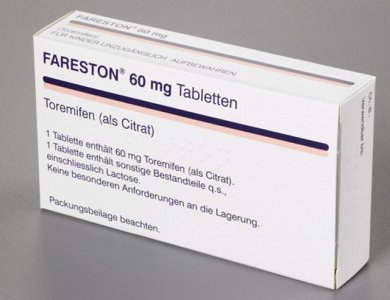Fareston (toremifene citrate) is a Selective Estrogen Receptor Modulator (SERM) derived from triphenylethelyne. It is Licensed in the United States under the brand name “Fareston” and currently FDA approved for use in advanced (metastatic) breast cancer. It is currently being studies for use in prostate cancer as well.
Background
Toremifene Citrate was originally patented as Fareston by the Orion Corporation of Finland, and approved for the treatment of breast cancer in Europe in 1996. In September of 1999, Roberts Pharmaceutical Corporation was granted the rights to market the drug in the United States of America.
Action
Toremifene Citrate exerts its effects by antagonizing the estrogen receptor in some tissues, and agonizing it in others. In this way, certain estrogenic pathways are activated and others are blockaded. It seems to exert estrogenic effects on blood lipids, reducing LDL and total cholesterol, as well as estrogenic effects on bone, improving density. It would also appear to exert anti-estrogenic effects in breast tissue, displacing the traditional effects of estrogen, effectively helping prevent breast cancer in postmenopausal women.

Technical Data
Fareston is a Selective Estrogen Receptor Modulator. Other drugs in this class are Clomid and Nolvadex. SERMs act by being an estrogen agonist in certain tissues and an estrogen antagonist in others.
In men, at the hypothalamus and pituitary, estrogen acts in cooperation with the body’s negative feedback loop to send a signal to decrease the secretion of LH. When LH secretion is lowered, so are natural testosterone levels. SERMs, like Fareston, possibly act as an estrogen antagonist in the hypothalamus and pituitary, in order to increase testosterone production. Thus, although it hasn’t been studied to any great degree, it’s highly likely that Fareston is capable (or better) of increasing testosterone in the same way that Nolvadex it, as it’s androgenicity:estrogenicity ratio is 5x that of Nolvadex (1). However, in terms of improving bone mineral density, Fareston is roughly equal to Nolvadex. (2) Fareston, like other SERMS, would appear to have very beneficial effects on blood lipid levels and other health markers.
User Notes
Although some of the research looks promising, and it may be the case that Fareston can have potential to elevate testosterone levels higher than other SERMs being currently used by bodybuilders and athletes, the jury is still out on that.
There simply have not been enough people using Fareston for long enough to know where its place in the steroid using milieu will eventually be. For now, it can be considered to have potential, but nothing more. I have high hopes for this drug to live up to it’s potential, but only time will tell.
If you’re considering adding it into a cycle, just be sure to keep other ancillaries on hand, just in case.
Toremifene Citrate is the chemical name of active ingredient in Fareston. Fareston is a registered trademark of U.S. of GTx, Inc. in the United States and/or other countries.
References
Background
Toremifene Citrate was originally patented as Fareston by the Orion Corporation of Finland, and approved for the treatment of breast cancer in Europe in 1996. In September of 1999, Roberts Pharmaceutical Corporation was granted the rights to market the drug in the United States of America.
Action
Toremifene Citrate exerts its effects by antagonizing the estrogen receptor in some tissues, and agonizing it in others. In this way, certain estrogenic pathways are activated and others are blockaded. It seems to exert estrogenic effects on blood lipids, reducing LDL and total cholesterol, as well as estrogenic effects on bone, improving density. It would also appear to exert anti-estrogenic effects in breast tissue, displacing the traditional effects of estrogen, effectively helping prevent breast cancer in postmenopausal women.

Technical Data
Fareston is a Selective Estrogen Receptor Modulator. Other drugs in this class are Clomid and Nolvadex. SERMs act by being an estrogen agonist in certain tissues and an estrogen antagonist in others.
In men, at the hypothalamus and pituitary, estrogen acts in cooperation with the body’s negative feedback loop to send a signal to decrease the secretion of LH. When LH secretion is lowered, so are natural testosterone levels. SERMs, like Fareston, possibly act as an estrogen antagonist in the hypothalamus and pituitary, in order to increase testosterone production. Thus, although it hasn’t been studied to any great degree, it’s highly likely that Fareston is capable (or better) of increasing testosterone in the same way that Nolvadex it, as it’s androgenicity:estrogenicity ratio is 5x that of Nolvadex (1). However, in terms of improving bone mineral density, Fareston is roughly equal to Nolvadex. (2) Fareston, like other SERMS, would appear to have very beneficial effects on blood lipid levels and other health markers.
User Notes
Although some of the research looks promising, and it may be the case that Fareston can have potential to elevate testosterone levels higher than other SERMs being currently used by bodybuilders and athletes, the jury is still out on that.
There simply have not been enough people using Fareston for long enough to know where its place in the steroid using milieu will eventually be. For now, it can be considered to have potential, but nothing more. I have high hopes for this drug to live up to it’s potential, but only time will tell.
If you’re considering adding it into a cycle, just be sure to keep other ancillaries on hand, just in case.
Toremifene Citrate is the chemical name of active ingredient in Fareston. Fareston is a registered trademark of U.S. of GTx, Inc. in the United States and/or other countries.
References
- Breast Cancer Re Treat. 1990 Aug;16 Suppl:S3-7. Introduction to toremifene. Kangas L.
- Breast 2006 Apr;15(2):142-57. Epub 2005 Nov 9. Toremifene: An evaluation of its safety profile. Harvey HA, Kimura , MHajba A
